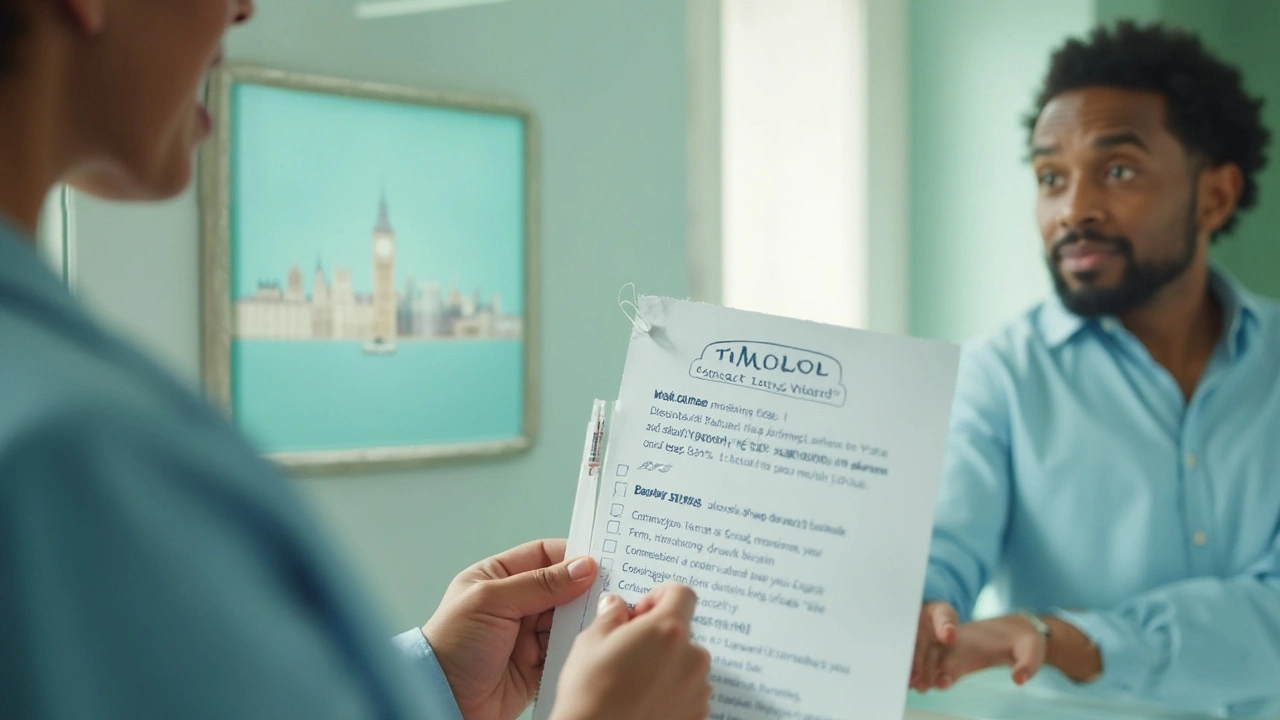If you've been prescribed Timolol and love wearing contact lenses, you might be wondering how these two can work together. This doesn't have to be a headache. Understanding the relationship between them is the key to managing your eye care routine effectively.
So, what's essential to know? First, Timolol is a beta-blocker often used in eye drops to help reduce pressure inside the eye. It's a go-to for those with glaucoma or ocular hypertension. But contact lenses can sometimes change how medications affect your eyes.
Let's focus on practical tips: When applying Timolol eye drops, it's a good move to take out your lenses beforehand. This prevents any unwelcome reactions and ensures the medicine works properly. Wait at least 15 minutes before popping them back in. This buffer gives the drops time to absorb without interference.
Another hot tip? Pay attention to your eyes. If they become irritated or feel different, give your eye care professional a shout. They can provide insights tailored to your specific situation.
- Understanding Timolol
- Best Practices for Combining Timolol and Contacts
- Potential Risks and How to Avoid Them
- Expert Tips for Eye Health
Understanding Timolol
So, what exactly is Timolol? It's a medication from the beta-blocker family, commonly found in eye drops. Its main gig: tackling eye pressure. When too much fluid builds up inside the eye, it can lead to problems like glaucoma. That's where Timolol steps in—lowering that pressure to keep your vision in check.
Now, you might be curious about how it actually works. Timolol helps reduce the production of fluid within the eye. This means less pressure is exerted on the optic nerve, the part of the eye that sends images to your brain. Keeping pressure in the normal range prevents damage that could lead to vision loss.
Who Uses Timolol?
People diagnosed with types of glaucoma or ocular hypertension often rely on Timolol. It's just part of their everyday routine to protect their sight.
Dosage Tips
Timolol eye drops are usually prescribed for once or twice a day use. It's crucial to follow your eye doctor's instructions because going off script can lead to complications.
Possible Side Effects
No one loves side effects, but they can happen. Some folks might experience temporary burning or stinging in the eyes after applying the drops. Others could notice blurred vision or dryness. If any side effects seem out of the ordinary or prolonged, get in touch with your healthcare provider.
And here's a handy fact: Timolol isn't just for people. It's used in veterinary medicine to help pets with similar eye issues. So, if both you and your furry friend have eye drops in the fridge, it’s not as odd as it sounds!
Best Practices for Combining Timolol and Contacts
Combining Timolol eye drops with contact lenses might seem tricky, but it's totally doable with the right approach. First things first, let's get into why timing is everything.
Wait and See: Timing Your Drops
Before you apply your Timolol drops, make sure to take out your contact lenses. Once the drops are in, it's smart to wait at least 15 minutes before putting your lenses back. This prevents any interactions that could mess with the medicine's effectiveness. It might seem a bit tedious, but it's the best way to make sure your eyes get the treatment they need.
Cleanliness is Key
Keeping things sanitary is a big deal when drops and lenses mix. Wash your hands thoroughly before you start handling drops or lenses to avoid any unwanted particles. This can't be overstated because your eyes are quite sensitive and easily irritated.
Hydration Matters
Timolol can sometimes cause dryness. If you notice this happening, consider using rewetting drops designed for contact lens wearers during the day. Just remember to check if they're compatible with your specific lenses.
Check Your Symptoms
Always be on the lookout for any unusual symptoms after combining Timolol with lenses. Redness, itching, or discomfort needs to be addressed, so don't hesitate to chat with your eye doctor if anything feels off.
Following these best practices helps ensure that you're using Timolol effectively while keeping your contacts comfortable all day.

Potential Risks and How to Avoid Them
Mixing Timolol with contact lenses isn't without its risks, but don't worry, they're manageable with the right know-how. Let's dive into some potential hiccups you might face and how to sidestep them.
Risk of Eye Irritation
Combining Timolol eye drops with contact lenses can sometimes irritate your eyes. The preservatives found in some eye drops might stick to the lens surface and lead to discomfort or even redness. An easy fix? Opt for preservative-free eye drops if available.
Improper Absorption
Contact lenses can delay or reduce the absorption of the medication. The best way around this is to remove your contacts before administering the drops. Waiting at least 15 minutes after you've applied the drops before putting your lenses back in is a smart move that can make a big difference.
Keeping Lenses Clean
There’s always a chance that using eye drops with lenses still in can leave a residue. This could end up clouding your vision or messing with how your lenses fit. Regularly sterilize your contacts to avoid this.
Allergic Reactions
Watch out for signs of an allergic reaction. Symptoms like itching, swelling, or burning could mean you’re reacting to the Timolol. In this case, reach out to your eye care provider pronto to explore alternative treatments.
Quick Checklist
- Remove lenses before using Timolol eye drops.
- Wait 15 minutes before reinserting lenses.
- Opt for preservative-free eye drops if possible.
- Maintain regular lens cleaning and sterilization.
- Consult your doctor if you experience any unusual symptoms.
Armed with these tips, managing your contact lenses while using Timolol becomes straightforward. Your eyes will thank you for the effort you invest in their health!
Expert Tips for Eye Health
Keeping your eyes in tip-top shape while using Timolol and wearing contact lenses can be a breeze if you follow a few expert tips. Here's a rundown of some proven strategies.
Stay on Schedule
Sticking to your medication schedule is super important. Timolol works best when taken consistently. If you're forgetful, set reminders on your phone. Regular dosing ensures optimal control over eye pressure.
Keep Your Lenses Clean
Dirty lenses are a no-go. They're not just uncomfortable—they can mess with Timolol's effectiveness. Make sure you clean them properly. Use the right solution and follow the necessary steps to keep those lenses crystal clear.
Follow the 15-Minute Rule
Remember that post-drop wait time? It's a solid practice to wait at least 15 minutes after applying your Timolol before putting your contacts back in. This little pause guarantees the drops are fully absorbed, giving Timolol the chance to do its magic without the risk of lenses soaking it up.
Watch for Changes
Your eyes might tell you a lot! If something feels off, like noticeable redness or irritation, hit up your eye doctor. Ignoring these symptoms can lead to bigger issues, and your doctor might adjust your treatment plan accordingly.
Eat Right for Eye Health
Think of food as fuel for your eyes. Eating foods rich in vitamins A, C, and E, along with minerals like zinc, can really boost your eye health. Incorporate leafy greens, nuts, and fish into your diet.
| Nutrient | Source | Benefits |
|---|---|---|
| Vitamin A | Carrots, sweet potatoes | Improves vision |
| Vitamin C | Oranges, strawberries | Antioxidant protection |
| Zinc | Nuts, seeds | Supports retinal health |
Taking these small steps can make a big difference in how your eyes handle the combo of Timolol and contact lenses. Happy eyes mean clearer vision and fewer complications!



Comments
Hey folks! I just wanted to say this guide about Timolol and contacts is super helpful! I’ve been using Timolol drops for a bit now and honestly, contact lenses always made me nervous with meds involved. Glad to see there are tips to avoid irritation and tricky issues.
One thing that helped me was making sure I wait a good 15 minutes before putting my contacts back in after the drops. Feels like my eyes get less dry and irritated that way. Anyone else experience that?
And omg, the bit about removing lenses before sleeping while on Timolol is so crucial—don’t skip it!
Thanks for sharing this, really gives me peace of mind to keep wearing my lenses comfortably. Keep these guides coming, please!
This is a clear and friendly overview! I love the gentle reminders about hygiene and timing when using Timolol with contact lenses.
For those worried about discomfort, just remember: always wash your hands before applying drops! It really reduces risks of infections. Also, the article's note about consulting your eye doctor if you feel unusual symptoms is key. Don't just ignore redness or itching.
It’s all about caring for your eyes responsibly, and this article does a great job pointing that out without scary jargon. Let’s keep supporting each other through these little health journeys.
Good read. The article summed up the essentials nicely. It’s important to highlight that some patients might have to switch to glasses temporarily if they face serious discomfort.
I'd add: people shouldn’t hesitate to mention any issues to their optometrist early on. It can prevent bigger problems.
Otherwise, using Timolol with contacts is manageable with proper care.
Ah, the delicate dance of medication and lenses—very fascinating. What strikes me is how we balance caution and comfort. Timolol, while effective in reducing eye pressure, interacts subtly with the environment of our eyes, especially if we layer contacts on top.
We sometimes overlook how much our eyes thrive on proper oxygen and moisture. Timolol can challenge that balance by potentially reducing tear production. Combine that with lenses, and you could face friction and dryness.
I’d love to explore if certain lens materials perform better with Timolol. Could newer silicone hydrogels offer an advantage? Anyone seen data or anecdotal evidence?
Indeed, the interplay between a beta-blocker like Timolol and contact lenses is a multifaceted issue!!!
To underscore the paramount point: patients must administer drops first, then wait approximately 15 minutes before contact insertion—this timing is critically important!!! Not merely a suggestion but a recommended protocol to prevent compromised drug absorption or lens contamination!!!
Furthermore, it behooves healthcare providers to educate patients prolifically about the potentially subtle side effects and the imperative necessity of hygiene in this context!!!
Oh, wonderful, yet another profoundly serious article telling us the earth is flat when wearing contacts on Timolol drops. How utterly groundbreaking. Truly, we couldn't have guessed that proper hygiene and timing matter. Bravo.
In all seriousness, I suppose for the careless, these reminders might help, but for anyone with a shred of common sense, this is just… yeah, usual advice wrapped up in a neat little package.
Still, do remember not to terrify patients. The balance is key; you’re not going to spontaneously combust if you wear Timolol and contacts, folks.
Really insightful points here, particularly about patient compliance with timing and lens removal. From my experience in the UK, many folks underestimate how delicate this balance can be without creating a fuss.
I appreciate how clearly the article frames it without too much jargon, though I’d love to see more on the differences between various contact lens types in relation to Timolol use. Do all lenses behave equally under these conditions?
Also, as someone who’s had mild glaucoma, I can’t stress enough the value of patience and care in applying eye medication alongside your lifestyle.
Honestly everyone just talks about timing and hygiene like that solves everything, but what about the actual discomfort some of us feel? Like sometimes I put the drops in and my eyes sting badly for hours but I need the med to keep the pressure down. Wearing contacts just adds to that mess.
Doctors say 'give it time' but isn’t there another solution? I feel like we get told to be patient but we don’t talk about alternate meds or lenses that might not aggravate the irritation.
Does anyone here have a real fix besides just waiting through the pain?
I totally hear you on the discomfort issue! It’s so discouraging when you have to take care of your eyes but keep feeling that sting. One thing that helped me a lot was switching to daily disposable lenses while on Timolol. It cut down on debris and irritation dramatically.
Also, lubricating eye drops safe with contacts really saved me some dryness. I always check with my doc before mixing anything, of course.
It’s about creating a care routine that fits your unique eyes. Patience plus the right products = game changer!
Don’t be afraid to bring these struggles up with your ophthalmologist. They can tailor your treatment just for you.
So tired of these articles telling me to wait longer after applying drops before putting contacts back in. Like, sure, that's fine for some, but what about when you're in a rush? I get it, but life doesn't always wait.
Still, this article does explain things better than most, so I'll give it credit for that. Simple advice about removing lenses before sleeping is also a nice reminder.
At least I know what not to do now.
This article is unfortunately yet another pedestrian attempt to address what is, frankly, a nuanced issue with quite a bit of complexity.
Most people fail to grasp the subtle biochemical interactions at play when beta-blockers like Timolol are combined with the microenvironment changes induced by contact lenses. One cannot simply shrug off these interactions as mere timing or hygiene matters.
A far more sophisticated understanding of ocular pharmacokinetics and material science impact is necessary for advanced patients and practitioners alike.
But alas, for many, this guide will suffice as the 'basics' are all that seem to be conveyed in popular media.
Just jumping back in — totally respect the deeper scientific angles mentioned. However, for everyday users, the practical tips here provide a great starting point. It’s not either-or; you can appreciate the complexity and still use proven simple steps to protect your eyes.
Plus, sharing experiences like these helps us all learn and improve our routines over time.